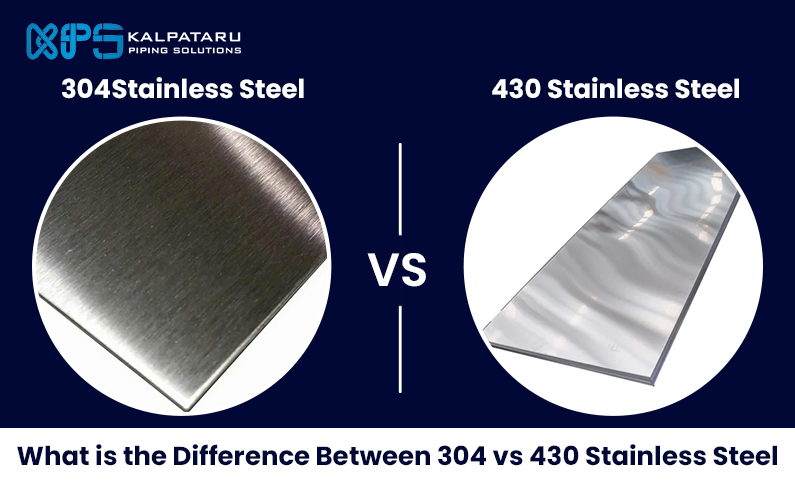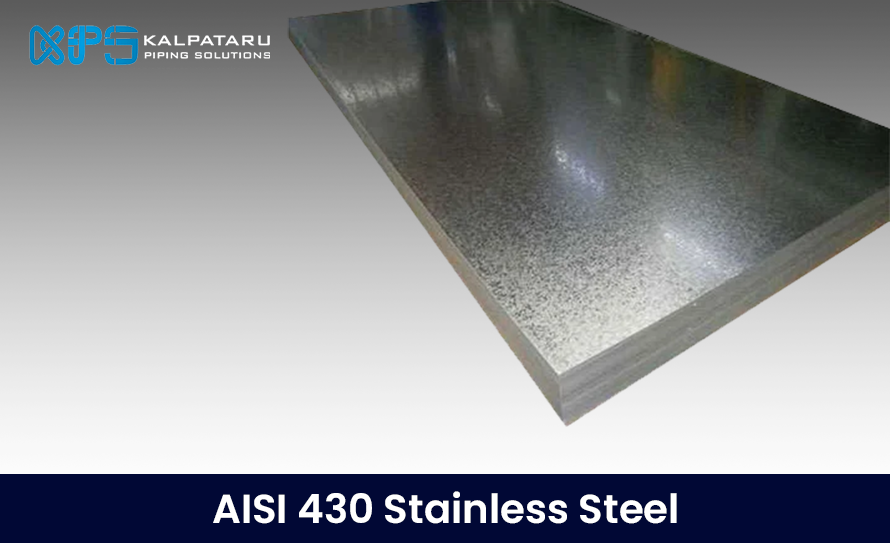304 and 430 stainless steel are two popular types of stainless steel, each with distinct compositions and uses.
304 stainless steel contains a minimum of 18% chromium and 8% nickel, making it highly resistant to corrosion and suitable for items that come into contact with food, such as kitchen appliances and cutlery.
430 stainless steel, by contrast, has a minimum of 16% chromium but does not contain nickel, which makes it less resistant to corrosion compared to 304. However, it is still often used for food-contact items like cookware and tableware due to its durability and affordability.
Each type is chosen based on the specific needs of food safety, durability, and resistance to wear in different kitchen environments.
What is 304 Stainless Steel?
304 stainless steel is an alloy primarily made of chromium and nickel, known for its excellent resistance to corrosion. This property makes it ideal for applications where protecting against rust and corrosion is essential, such as in food processing, kitchen equipment, and medical devices.
Additionally, 304 stainless steel is easier to shape and work with compared to many other stainless steel types. This ease of fabrication makes it a popular choice for projects that require precision and accuracy, as it can be formed into complex shapes without sacrificing strength or durability.
What is 430 Stainless Steel?
430 stainless steel is a corrosion resistant alloy known for its hypoallergenic properties. It offers durability against harsh environments and chemicals, making it a practical choice for various applications.
This type of steel is commonly used in industries such as medical devices and food packaging due to its ability to withstand high temperatures and resist acidic conditions, ensuring long-lasting performance in challenging environments
What is the Difference Between 304 and 430 Stainless Steel?
304 and 430 stainless steel are commonly used in different applications, each offering unique properties.
304 stainless steel is more widely used in food-grade environments, such as kitchen equipment and appliances, due to its higher resistance to corrosion. It contains around 18% chromium and 8% nickel, giving it excellent durability and formability.
On the other hand, 430 stainless steel is typically used in industrial and construction settings. It has a lower nickel content and contains around 16% chromium. This composition gives it good resistance to corrosion and makes it a great choice for applications where wear and tear are expected, like kitchen utensils and industrial tools.
While 304 is more corrosion-resistant due to the addition of nickel, 430 offers greater hardness and is more suitable for environments where mechanical stress is higher. Both materials are durable and reliable, but the choice between them depends on the specific requirements of the application.
430 Stainless Steel vs. 304 Stainless Steel
- Cost :- The cost of stainless steel is largely driven by the price of the metals in its composition, which can fluctuate daily on global markets. Generally, 304 stainless steel is more expensive than 430 due to its higher nickel content—304 contains around 8-10.5% nickel, while 430 has none. Nickel not only boosts corrosion resistance in 304 but is also costly, making 304 more expensive than 430.
- Magnetism :- Magnetic properties also differ between these two grades. 304 stainless steel, classified as an austenitic grade, is typically non-magnetic but can develop magnetic qualities after cold working (such as cutting). In contrast, 430 is a ferritic grade, which makes it inherently magnetic. However, it’s important to note that not all magnetic stainless steels are 430, and not all non-magnetic ones are 304—magnetic properties vary based on processing and composition across different grades.
Chemical composition 304 vs 430 stainless steel
| Grade | C | Si | Mn | P | S | N | Cr | Ni |
| 304 | 0.07 | 1.00 | 2.00 | 0.045 | 0.015 | 0.10 | 17.5 – 19.5 | 8.0 – 10.5 |
| 430 | 0.08 | 1.00 | 1.00 | 0.040 | 0.015 | – | 16.0 – 18.0 | – |
Corrosion Resistance
Stainless steel is generally resistant to corrosion, but some grades are better at it than others. The nickel content in 304 stainless steel gives it superior corrosion resistance compared to 430. However, this added nickel also raises the cost. When budget is more important than extended durability, 430 may be a suitable choice.
Pressing and Drawing
Nickel in 304 not only improves corrosion resistance but also makes it easier to press and draw into shapes. Since 430 lacks nickel, it’s more prone to cracking or failing during pressing compared to 304, making 304 a better option for applications requiring shaping or forming.
Conclusion
304 and 430 stainless steel each have unique advantages, making them suited to different applications. 304, with its higher nickel content, offers better corrosion resistance and formability, making it ideal for food-grade, medical, and demanding industrial applications. On the other hand, 430 is a more cost-effective option with good corrosion resistance and high magnetism, suitable for less demanding environments where durability is still important but cost is a priority. Choosing between them depends on the specific requirements for corrosion resistance, magnetism, and budget.
FAQs
Which is better: 316 or 430 stainless steel?
316 stainless steel offers superior resistance to chemicals and salt, making it ideal for corrosive environments, while 430 is a cost-effective option for moderate food-grade applications.
What is the difference between 304 and 403 steel?
403 stainless steel has 16-18% chromium and minimal nickel, giving it lower corrosion resistance compared to 304, which has higher chromium and nickel content.
Is 430 stainless steel good quality?
430 stainless steel is good quality, especially for applications needing moderate corrosion resistance at a lower cost. However, 304 stainless steel generally provides better corrosion resistance and durability, making it more suitable for harsher environments.




